Guest Post by Emily Visness, The Bookish Advocate. Thanks to Emily for joining us to share her tips for managing a classroom library.
Building a classroom library is a rewarding journey, one that is never quite complete. When people see the filled bookshelves in my classroom library, they tend to ask a lot of questions. Other teachers always seem to be interested in how I manage all those books! I am certainly not original in my organization or my systems—I learned by reading a lot of blogs, reading a lot of PD books, and talking to a lot of teachers about their own classrooms. Now, I’d like to pass along the information I’ve learned, as well as some tips and tricks, to anyone else who is interested in beginning their own journey with their students, a classroom library, and independent reading. So, here are the answers to those questions!
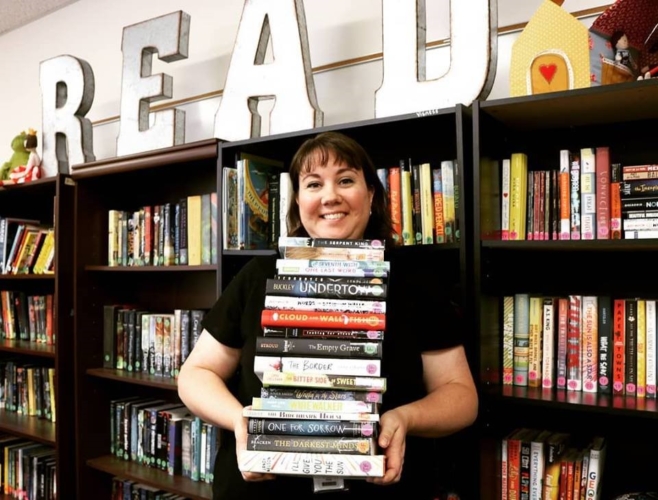
How do you organize your classroom library?
I choose to organize the books by genre. The genres I use are: Science Fiction, Fantasy, Horror, Non-fiction, Graphic Novel, Historical Fiction, Realistic Fiction, Teen Fiction, Mystery/Suspense, and Poetry.
 What do those round stickers on the spine mean?
What do those round stickers on the spine mean?
To make it easy for students to re-shelve and find books, I put a label (a garage-sale sticker marked with a Sharpie) on the spine of each book with a code for each genre. For example, Science Fiction is SF, Teen Fiction is TF, Mystery/Suspense is MS, Fantasy is F, and so on. I made a poster that hangs next to the bookshelves that is a key for the label codes so students can easily understand what each code means. This makes it easy for students to look for books in the genres they prefer, and easy for me to find books without having to maintain an alphabetical system. (Tip: use packing tape over the labels to keep the stickers on!)
Do you get any pushback for having those books on your shelves?
I use a genre label that I call Teen Fiction. I teach 8th graders, who can range in age from 12-15 years old, and while many of them are ready to read books with mature themes and content, some are not. I want them, and their parents, to be aware that they are reading a book that is solidly in the YA category. Teen Fiction in my library is still realistic fiction—it just contains themes appropriate for teenagers. Likewise, I use the genre of Realistic Fiction to label those books that fall more in the Middle Grade category. Middle grade books are typically written for students in grades 4-7, but I don’t want to advertise that to my 8th graders. After all, a good book is a good book, no matter the age of the person for which it was written! What everyone really wants to know is if a parent has ever challenged a book. The answer is—no. Parents sign a letter giving permission for their student to use the classroom library, and part of that letter requires parents to understand that if their child brings home a book they aren’t ready to read, the procedure is to simply trade it for a different book. I understand that past experience doesn’t necessarily predict future events, but this system has worked well for me, and for my students and their families.
How do you keep track of the books your students check out?
Glad you asked! Booksource Classroom is the perfect tool to address all checkout needs. I downloaded the app to my phone, and using that I can scan new books into my online classroom library. Once I’ve added students to the system, I can easily find a student’s name, scan a book, and checkout the book directly to that student. I can run reports that tell me which books are checked out, and a report that tells me how frequently books are checked out, which helps me identify trends in student reading and the popularity of books. I also use the reports to do an inventory check twice a year. Many types of reports are available to meet the varying needs of all teachers. Using Booksource Classroom also helps me retain books in my library. Last year, I only lost four books to theft, which was much better than I anticipated! I know that the Booksource Classroom was a huge help in reducing loss.
How do you get your students interested in reading all those books?
Every day after independent reading time is over, which in my classroom lasts for 10-15 minutes, I do 2-3 booktalks. Booktalks last about one minute for each book, and consist of me telling students about a book in a way that will make them want to leave class with that book in their hands. Basically, I’m a bookseller, the students are customers, and I’m handselling a book. (I guess that college job at the bookstore in the mall is paying off!) Tip: Before I begin booktalks, my students are required to open their Reader/Writer notebooks to their TBR (To Be Read) page. Every student is expected to maintain a TBR page, because after all, what do good readers do? They have a plan on what to read next! Back to booktalks—every week I pull several books from my shelves and place them on my Booktalk Bookshelf, or BTBS.
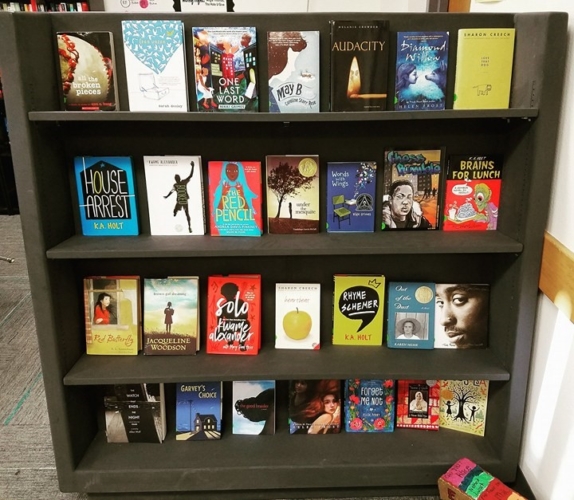
The display on the BTBS is sometimes by genre (like the novels in verse shown here), or because there are new books to share. Other times, I pull books to celebrate diversity awareness months. Then, every day, I pull books from the BTBS to booktalk to my classes. Booktalks are fun and easy, even if you haven’t read the book (yet!). A great booktalk is more than just reading the blurb on the inside cover—which means you may need to prepare a little in advance. Great booktalks require book knowledge, excitement, and a short read-aloud. Sometimes I read the first paragraph, other times I choose a passage in the book that will get kids interested in reading. Whichever way you choose to give your booktalks, excitement and passion are key!
How do you choose new books?
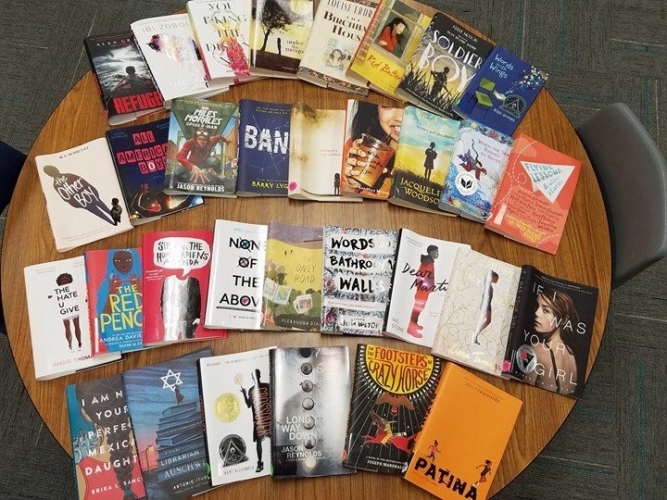 Choosing new books is so much fun! It seems I always have a particular student in mind when I’m looking for books. I find out about books by student request, by following book news on social media, by reading blogs, and by (sometimes) looking at award winning books. Once I started participating in the Kid Lit world in these ways, great books just started finding me—that’s the spooky magic of the internet! When choosing books for my classroom library, I ask myself three questions.
Choosing new books is so much fun! It seems I always have a particular student in mind when I’m looking for books. I find out about books by student request, by following book news on social media, by reading blogs, and by (sometimes) looking at award winning books. Once I started participating in the Kid Lit world in these ways, great books just started finding me—that’s the spooky magic of the internet! When choosing books for my classroom library, I ask myself three questions.
1) Whose story is not currently represented on my shelves?
2) Is this story good representation of the groups to which the characters belong?
3) Is this an #OwnVoices book?
If you aren’t familiar, an #OwnVoices book is one in which the author is a member of the same marginalized group as the characters in the book, which is important to consider when looking for good representation. Tip: Do a little research, follow the hashtag on Twitter, look up reviews of the book, and read them! The last thing we as teachers want to do is harm a child by perpetuating negative stereotypes. The books we choose should lift kids up with inclusive, accurate, and positive content about marginalized characters. It’s okay to be choosy! Your students will thank you by checking out and reading lots of books!
Classroom libraries are managed in all sorts of ways, but one thing all teachers can agree on is that surrounding kids with books, choice, and time to read is beneficial to their lifelong learning and success. So, here’s to a wonderful, book-filled school year! Happy reading!
About the Author:
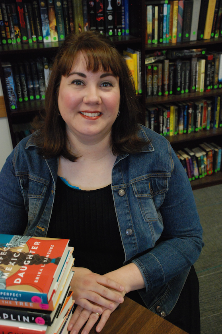
Emily is an 8th grade ELA teacher who actively works to put relevant books into her students’ hands, a believer in the importance of diverse literature for young people, a lover of banned or challenged books, and an advocate for all students’ right to read. She writes about her experiences and opinions on reading, teaching, and books on her blog The Bookish Advocate. You can also find her on Facebook (The Bookish Advocate), Twitter (@bookishadvocate), and Instagram (TheBookishAdvocate).


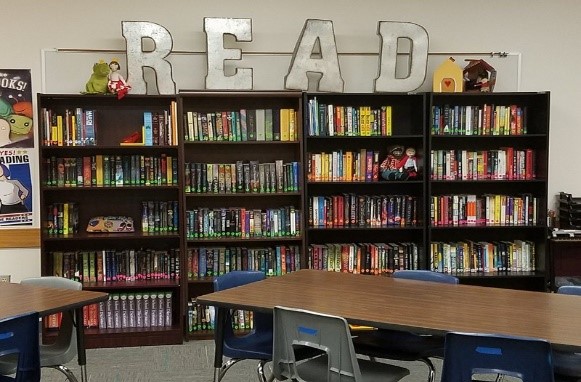
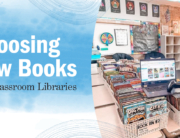
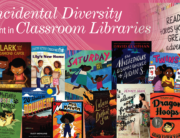

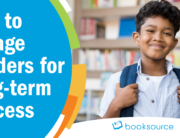
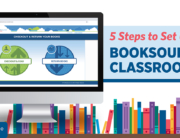
Leave A Comment